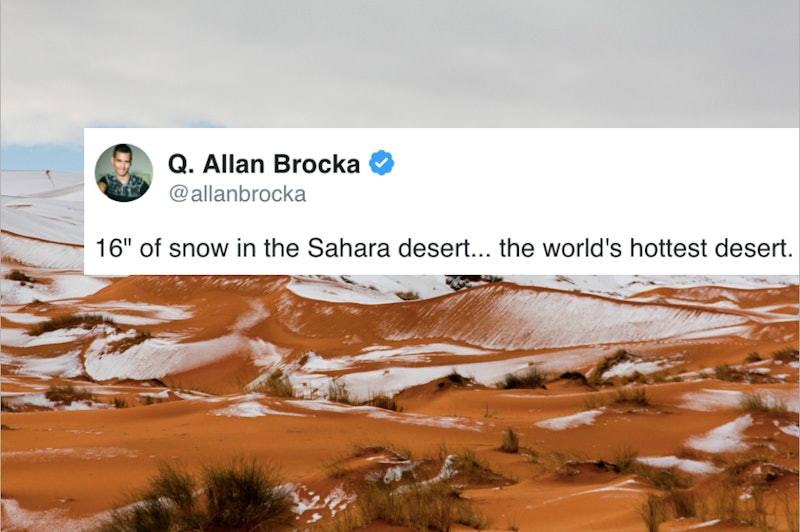News
11 Photos Of The Sahara Desert Covered In Snow That Will Literally Take Your Breath Away

One of the hottest regions on earth, known for its miles upon miles of rolling sand dunes and temperatures upward of 104 degrees, recently saw weather more characteristic of the northeastern United States. On Sunday, approximately 15 to 16 inches of snow fell in parts of the Sahara Desert. Photos of the snowfall in Aïn Séfra, an Algerian municipality in the Sahara sometimes referred to as the "Gateway to the Desert," spread across social media, and residents in the desert town were reportedly thrilled at the relative anomaly.
"When you walk in the snowy dunes, you feel like you are in Mars or Uranus," Kamel Sekkouri, who grew up in the area, told The New York Times; he described the spectacle as "incredible, unbelievable, magical, sensational."
Algerian news reports claim that this is the fourth time it has snowed in the area in the last 40 years. However, meteorological experts have told the Times that it's impossible to know how frequently it snows in the Sahara as a whole, because it is about the size of the United States and weather monitoring isn't quite as thorough. Additionally, it isn't always scorching in the Sahara — in December, the average high in the area is reportedly about 50 degrees Fahrenheit, and lows average in the upper 30s.
Stefan Kröpelin, a geologist at Germany's University of Colognen, in an interview with the Times, cautioned against sweeping claims about the rarity of snow in the desert.
The Sahara is as large as the United States, and there are very few weather stations. So it's ridiculous to say that this is the first, second, third time it snowed, as nobody would know how many times it has snowed in the past unless they were there.
While the snowfall may not have been quite as unusual as some believe, residents were not deterred. Photos and videos of locals climbing the snow-covered dunes took off across Twitter.
The Washington Post reports that it also snowed in Aïn Séfra in 2017. Before that, there was a 30-minute long snow-storm in 1979.
Climate researcher Rein Haarsma told the Times that the weather responsible for the snow would normally hit Scandinavia. However, high pressure systems pushed the storm system much further south than it would normally land, resulting in the unusual snow storm. This particular cold air system was actually the same one to hit the United States back in December.
Haarsma also warned against attributing the storm to human-induced climate change — "There is exceptional weather at all places, and this did not happen because of climate change," he told the Times. He explained that geography combined with reasonable weather patterns from the north were more likely to blame for the frozen precipitation.
Rising temperatures began melting the snow later in the same day, but residents reportedly took advantage of the opportunity to get in some sledding before it disappeared.
A spokeswoman from the United Kingdom's national weather service, Met Office, told The Independent that most of the photos shared on social media appeared to have been taken near the Atlas Mountains. The region's high elevation would make the area more susceptible to snow fall than other parts of the desert, she explained. (Aïn Séfra is situated within the North African range.)
While the intense heat and dryness of the Sahara has been well-mythologized in popular culture over the years, Forbes reports that as recently as 5,000 years ago, the region is believed to have been fertile and well-inhabited by both humans and animals. This climate phase, known as the African Humid Period, lasted about 10,000 years before dryness suddenly took over, creating the desert we know today.
While experts were quick to point out that the weekend's weather event was likely unrelated to wide-sweeping climate change, the photos and videos of the Sahara Desert covered in snow are definitely a strange sight. How regular an event snowfall is for the region is unclear, but twice in the last several years alone is definitely monumental, at least for locals.